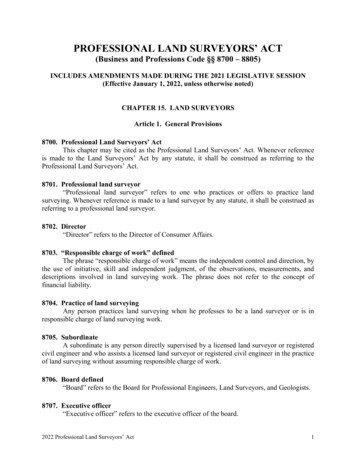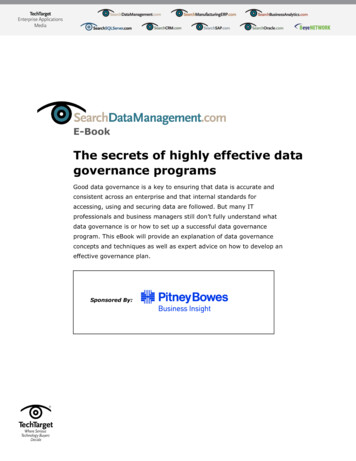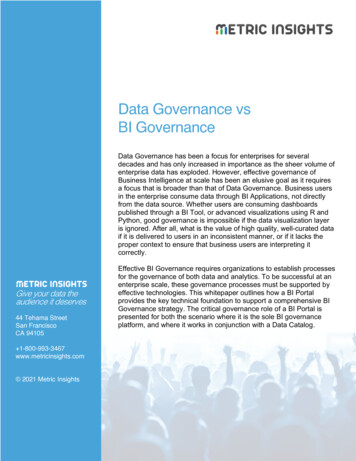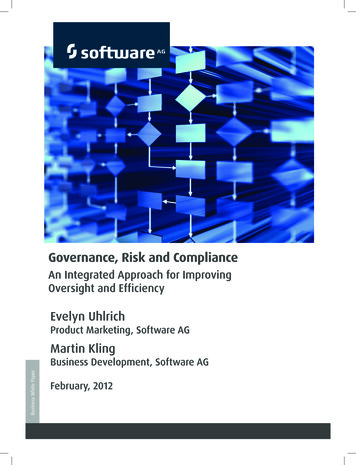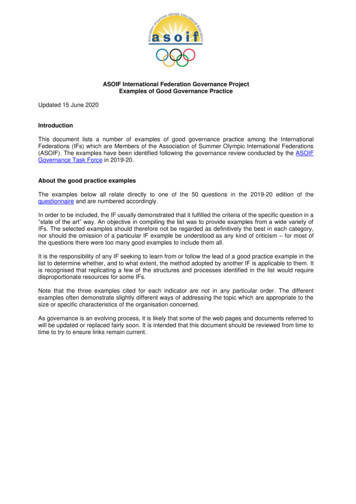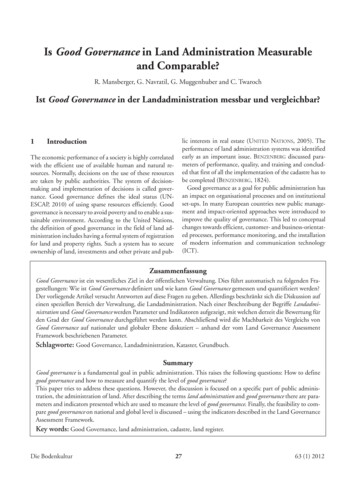
Transcription
Is Good Governance in Land Administration Measurableand Comparable?R. Mansberger, G. Navratil, G. Muggenhuber and C. TwarochIst Good Governance in der Landadministration messbar und vergleichbar?1lic interests in real estate (UNITED NATIONS, 2005). Theperformance of land administration systems was identifiedearly as an important issue. BENZENBERG discussed parameters of performance, quality, and training and concluded that first of all the implementation of the cadastre has tobe completed (BENZENBERG, 1824).Good governance as a goal for public administration hasan impact on organisational processes and on institutionalset-ups. In many European countries new public management and impact-oriented approaches were introduced toimprove the quality of governance. This led to conceptualchanges towards efficient, customer- and business-orientated processes, performance monitoring, and the installationof modern information and communication technology(ICT).IntroductionThe economic performance of a society is highly correlatedwith the efficient use of available human and natural resources. Normally, decisions on the use of these resourcesare taken by public authorities. The system of decisionmaking and implementation of decisions is called governance. Good governance defines the ideal status (UNESCAP, 2010) of using sparse resources efficiently. Goodgovernance is necessary to avoid poverty and to enable a sustainable environment. According to the United Nations,the definition of good governance in the field of land administration includes having a formal system of registrationfor land and property rights. Such a system has to secureownership of land, investments and other private and pub-ZusammenfassungGood Governance ist ein wesentliches Ziel in der öffentlichen Verwaltung. Dies führt automatisch zu folgenden Fragestellungen: Wie ist Good Governance definiert und wie kann Good Governance gemessen und quantifiziert werden?Der vorliegende Artikel versucht Antworten auf diese Fragen zu geben. Allerdings beschränkt sich die Diskussion aufeinen speziellen Bereich der Verwaltung, die Landadministration. Nach einer Beschreibung der Begriffe Landadministration und Good Governance werden Parameter und Indikatoren aufgezeigt, mit welchen derzeit die Bewertung fürden Grad der Good Governance durchgeführt werden kann. Abschließend wird die Machbarkeit des Vergleichs vonGood Governance auf nationaler und globaler Ebene diskutiert – anhand der vom Land Governance AssessmentFramework beschriebenen Parameter.Schlagworte: Good Governance, Landadministration, Kataster, Grundbuch.SummaryGood governance is a fundamental goal in public administration. This raises the following questions: How to definegood governance and how to measure and quantify the level of good governance?This paper tries to address these questions. However, the discussion is focused on a specific part of public administration, the administration of land. After describing the terms land administration and good governance there are parameters and indicators presented which are used to measure the level of good governance. Finally, the feasibility to compare good governance on national and global level is discussed – using the indicators described in the Land GovernanceAssessment Framework.Key words: Good Governance, land administration, cadastre, land register.Die Bodenkultur2763 (1) 2012
R. Mansberger, G. Navratil, G. Muggenhuber and C. TwarochAn important question connected to this topic is how tomeasure, how to quantify and/or how to compare good governance (between countries). These activities are required tocontrol and to monitor public administration, especiallywhen introducing new managing systems.Although the necessity for good governance in land administration is clearly understood, the fund of provenstrategies, of detailed guidelines, and of proper proceduresto achieve good governance is still limited: On the one handthe existing land administration systems are not comparable due to their different historic developments and theirvarious legal and technical implementations. On the otherhand the quality of governance is defined by interacting andsometimes mutually contradictory principles. Thus theweighting of specific principles and with it the definition ofgood governance is a subjective process. However, it shouldbe possible to identify general guidelines to improve governance for countries with similar economic standards, comparable legal systems, and similar types of land administration (FAO, 2007).2which have to be considered during the design and implementation phase of land administration systems.Land administration systems are typically grouped intoregistration of deeds or registration of title. In the systemsof registration of deeds the notary/lawyer is responsible forthe legality of the document and related rights. The registration office only processes the documents withoutchecking the legality. In systems of registration of title theregister itself becomes the authoritative record of the legalinterests and takes the place of the document. This avoidsextensive examination of prior deeds during a purchase ofland. Thus the data stored in the two systems are fundamentally different. Although in practice there is a gradualtransition between these systems (ZEVENBERGEN, 2002),some effects are still visible, e.g. in the protection of thirdparty rights.The type of the geographical reference and geometric representation of the administration units is a more technicalquestion. Possible solutions range from a simple set of coordinates defining the centre point of a piece of land to aprecise definition of boundary points within a global reference system. Verbal or graphical descriptions of boundariesor the use of local coordinate systems are solutions betweenthese extremes (NAVRATIL, 2011). General boundaries define the boundary out in the field by visible barriers andfixed boundaries use boundary markers like stones or metalmarks. The definition of fixed boundaries may then dependon coordinates of – visible or invisible – boundary points ina national reference frame.Traditionally land administration systems are modellingthe data within a planar coordinate system. However, intensified use of space in cities requires extended functionalities. Constructions are piled on top of each other and leadto situations where different objects like railways, publicshopping areas, and private apartments are stacked on thesame piece of land. This led to 3D systems for land administration (VAN OOSTEROM et al., 2011).Real property rights are always applicable to a certain limited space – usually a parcel (compare PERMANENT COMMITTEE ON CADASTRE, 2007). Additional aspects are realproperty rights with temporal limitation including timesharing or periodicity like grazing rights frequently requiredby nomadic societies.Public-right restrictions of landownership are an additional category of real property rights to be considered. Public-right restrictions define the limits of power that the rightof property provides to its holder because property rights donot exist in the abstract but are only defined within a spe-Land AdministrationLand administration is defined as the operational implementation of land management and also as “the processes ofdetermining, recording and disseminating information aboutthe ownership, value and use of land when implementingland management policies” (UNITED NATIONS, 1996).“Land management is the process whereby the resources ofland are put to good effect” (DALE and MCLAUGHLIN,1988).Land administration consists of three interrelated parts:(1) the legal framework, (2) the data, and (3) the processesto access and change these data. “The legal framework protects private land rights and sets out the role of the state, theterms under which compulsory purchase can be carried out andthe means by which conflicts can be resolved” (FAO, 2007).The data can be grouped into physical data describing thephysical properties of the land or the real property, legaldata documenting the rights and duties to the real property, and finally data about the stakeholders.Land administration systems can be implemented in different approaches, as shown by BOGAERTS and ZEVENBERGEN (2001). A systematic classification does not yet exist, asdecision criteria are not always independent from each other.However, it is a fact that there are legislative, institutional, financial, procedural, managerial, and service oriented issues,Die Bodenkultur2863 (1) 2012
Is Good Governance in Land Administration Measurable and Comparable?cific society, which itself is defined by legal regulations(compare FREYFOGLE, 2007).3 The World Bank ranks economies on their ease of doingbusiness based on 10 parameters (http://www.doingbusiness.org/EconomyRankings). These performance figuresare yearly updated and the change of rankings is documented. There are criticisms about some simplificationsin measuring economic development (KERN, 2009).Good GovernanceGood governance is well-known as an important goal of governments to achieve prosperity for the country. But it ismore difficult to define it exactly and to describe its characteristics. Criteria as introduced in the last section help toclassify systems, but they cannot be used to assess the levelof quality of land administration issues. Quantifiable indicators are necessary for such an assessment. However, thechallenge is to find proper indicators for monitoring thequality of governance in specific countries and for comparing the level of good governance between countries.“Governance is the process of decision-making and the processby which decisions are implemented” (UNESCAP, 2010) or“governance is the exercising of authority or control” (BELL,2007).Good governance is the result of a successful implementation, a proper arrangement, and an optimal interactionof policies, laws and institutions by guaranteeing the following principles (TÖRHÖNEN and GROVER, 2006): transparency and impartiality, legal security and rule of law,predictability and traceability, effectiveness and efficiency,equity and fairness, integrity and accountability, consensus orientation, civic engagement and public participation.The provision of evidence for good governance can beachieved by indicators. An overview of the scientific workcontributed by several public, private and non-governmental institutions to identify proper indicators for good governance is given by ZIMMERMANN (2006): The World Bank Institute (WBI) identified and quantified governance indicators for more than 200 countries,describing voice and accountability, political stability,government effectiveness, regulatory quality, rule of law,control of corruption. The Bertelsmann Foundation Transformation Index isquantifying the status of governance in approx. 120 countries and visualising it on an interactive global map. TRANSPARENCY INTERNATIONAL (2009) publishes theCorruption Perception Index (CPI) of 180 countries andupdates these data every year.Indicators and the comparison of indicators with others(benchmarking) also enables an improvement of governance by helping to identify strengths and weaknesses of the characteristics of governance outlined above, and enabling changes, innovations and increased performance needed to deliver modern civil services.4The terms good governance and land administration are defined and described in Chapters 2 and 3. The pending questions are: (1) How is good governance in the field of landadministration defined? (2) Is there a possibility to quantify good governance for land administration systems byusing indicators which describe the principles of good governance outlined above? (3) Is it possible to monitor the development of good governance within a country? (4) Canlevels of good governance be compared between differentcountries? The following subchapters approach these questions.4.1Definition of Good Governance in LandAdministrationAccording to the definition, governance in land administration can be defined as the bundle of all processes of decision-making and of all implementations of decisions regarding land. Governance in land administration covers avery wide spectrum, ranging from land tenure, land use,land taxation, and land market, to land development. Governance in land administration has a political, a legal, a social, a technical, an ecological, and an economical dimension covering the following elements: land policy, land laws,and all involved institutions.Many investigations (e.g. FAO, 2007; BELL, 2007; ZAKOUT et al., 2007) have been done to define good governance. The quality of governance in land administrationcan be specified inAdditional performance indicators for good governance arepublicly accessible:Die BodenkulturGood Governance in Land Administration2963 (1) 2012
R. Mansberger, G. Navratil, G. Muggenhuber and C. Twaroch a target-orientated way by comparing predefined objectives in land administration with the achieved outcomes,and/or a process-orientated way by analysing the quality of theprocesses and methods used for governance in land administration.of private companies – Private-Public-Partnership; the consideration of gender issues in land aspects, the relevance ofecological matters in land management).4.2The predefined objectives or processes/methods can be defined in different levels of detail. They can be defined in avery high level of abstraction, e.g. by defining aims like theachievement of human rights in respect of freedom of property or equity in land distribution. It can also be done in avery concrete and detailed manner, e.g. by analysing theprocesses. This can address the number of steps required forregistering a land transfer, the time necessary, or the costs.In 2007, FAO published the following criteria and features that describe good governance in land administration(FAO, 2007):(i) The distribution of land rights is balanced between allcitizens. There is no discrimination on basis of race,gender, or religion.(ii) The national policy framework on land tenure andland rights issues is appropriate and the system forrecording and communicating land rights is legallybased and accessible.(iii) Land agencies serve all citizens.(iv) The legitimacy of land agencies and land administrators is recognized by citizens.(v) The processes for public land management, disposal,and privatization, as well as for expropriation or eviction for public purposes are transparent, fair, and accountable.(vi) The system for property valuation and taxation istransparent, equitable, and accountable.(vii) Services of land agencies fulfil the needs of customersand they are provided efficiently, effectively, andcompetently as well as with integrity, transparency,and accountability.(viii) The results of the services of land agencies are consistent, predictable, and impartial.The measurement of governance in land administration canbe characterized by (TÖRHÖNEN and GROVER, 2006) qualitative analysis (relationship between results of governance and defined aims) quantitative measures (use of indices and quantitativeanalysis).Indicators allow the comparison of services, products, processes, and methods between similar organisations. Indicators about good governance in land administration have toprovide maximum evidence by minimising the resourcesfor their acquisition and analysis. Indicators also allow tooutline the trends of performance changes within a countryfor a time period (FAO, 2007).The acquisition of indicators has gained importance inland administration institutions. Indices or measures areused to quantify (FAO, 2007; MANSBERGER et al., 2009) the degree of development of the political and legalframework, the performance of processes provided by the land agencies, the quality of services, the quality of the results of services (products), the level of satisfaction of customers, and the level of civil engagement and public participation.Proper indicators have to be accessed at the right moment,in useful time intervals, with an appropriate quality, withhigh significance, and finally with low resource input fordata capturing. Based on the published criteria and featuresof FAO (see Chapter 4.1) some difficulties and challengesfor the assessment of good governance are discussed in thefollowing paragraphs.(i) The distribution of land rights is balanced between all citizens. There is no discrimination on basis of race, gender,or religion.A countrywide land administration system documentsall persons and their land rights. This allows nationwide statistics on the distribution of land rights. Discrimination of specific groups can be easily outlined.The list covers a great range of good governance elements,but it does not claim completeness. Good governance canbe defined on a global level, on a regional level, or on a locallevel. Therefore also the objectives, criteria, and features arevarying. Additionally, the definition and perception ofgood governance is a subject of change and therefore depends on the spirit of age (e.g., the degree of involvementDie BodenkulturMeasurement of Good Governance in LandAdministration3063 (1) 2012
Is Good Governance in Land Administration Measurable and Comparable?(ii)(iii)(iv)(v)(vi)There may be a mismatch between the legal basics andregional tradition, e.g., in countries of the south oftenland rights are defined gender-neutral, but due to traditional law, women are often discriminated (ENGLERTand MANSBERGER, 2008).The national policy framework on land tenure and landrights issues is appropriate and the system for recording andcommunicating land rights are legally based and accessible.The existence of an appropriate policy framework canbe verified. Problems can appear in the executive powerto implement these ideas enabled by the wide spectrumof possible interpretations. This complicates the comparison of quality of land policy between differentcountries. Even more difficult is the assessment of accessibility of the system for the local people, as socialeconomic issues – like educational deficits (like analphabetism, ENGLERT and MANSBERGER, 2008), travelexpenses, or the availability of required technology(e.g. internet) – may bias the results.Land agencies serve all citizens.The legitimacy of land agencies and land administratorsare recognized by citizens.These issues can hardly be assessed, as it is difficult tofind proper performance indicators to measure the percentage of citizens supported by the system. Problemscan rise by the definition of representative citizens, byidentifying the degree of support, and by quantifyingthe degree of legitimacy. A measure for the recognitioncould be the level of civil engagement and public participation. But how is the optimum defined? Is, e.g., aclearly structured administrative process without anykind of public participation worse than a chaotic realisation of public participation?The processes for public land management, disposal andprivatization, as well as for expropriation or eviction forpublic purposes are transparent, fair and accountable.The system for property valuation and taxation is transparent, equitable and accountable.The design of processes can be described. Indicators forintegrity and accountability, transparency and impartiality, predictability and traceability can be defined.The performance of processes provided by the landagencies can be investigated by indicators describingeffectiveness and efficiency.However, the challenge is the deviation between designand daily routine. Corruption may compromise the design significantly, whereas the temptation for corruptionincreases with complexity of processes (GURIEV, 2004).Die BodenkulturAlthough the level of corruption itself can be measured, as by the CPI of TRANSPARENCY INTERNATIONAL (2009), the impact of corruption to the quality of the land administration processes can hardly beassessed.(vii) Services of land agencies fulfil the needs of customers andthey are provided efficiently, effectively and competently aswell as with integrity, transparency and accountability.(viii) The results of the services of land agencies are consistent,predictable and impartial.These criteria are usually addressed by customer satisfaction surveys. Customer Satisfaction Indices (CSI)are strongly related to the experiences of citizens withtheir local authorities. Therefore CSI is a good indicator within an institution. Cross-country comparisonsare limited, as expectations of citizens in their respective countries can be different. Assessed results cantherefore lead to wrong conclusions.Land Equity International developed a systematic guidanceon governance in land administration with the aim to provide World Bank staff and development partners a proper diagnose and benchmark tool. This land governance assessment framework defines in a hierarchic order five thematicareas with – in total – 21 indicators and 80 dimensions. Thelevel of good governance has to be assessed by a panel of experts in land tenure, land use/policy, public land management, and land registry – based on the scoring of the predefined indicators and dimensions (DEININGER et al., 2010). Apilot study for testing this framework was successfully outlined for 5 countries (BURNS et al., 2010).4.3Comparability of Good Governance in LandAdministrationA periodical assessment of land governance within a country would enable the detection of changes, would identifyweaknesses of processes, products, and institutional set-ups,and would outline potentials for optimisation and/or improvements.Cross-border comparisons would identify countrieswith good governance. The benchmarking process wouldenable people or institutions involved in land administration to learn from those who are at the leading edge. Additionally the comparison of good governance with othercountries also would provide a feedback to the own performance.3163 (1) 2012
R. Mansberger, G. Navratil, G. Muggenhuber and C. TwarochThis raises the question of this paper’s title if good governance in land administration is measurable and comparable. The possibility to define and describe good governancequantitatively and/or qualitatively by proper indicators issketched in Chapter 4.2.But what about the comparability of good governance inland administration? Appraising the degree of good governance of a country or the comparison and ranking of countries on the topic of good governance is a more difficult taskdue to the following facts: Good governance is not an absolute condition. There israther a continuum between weak and good governance(FAO, 2007). The definition of good and weak is oftensubjective and depends on personal experiences, culturalbackground, and political ideology. Throughout the globe, land administration is organisedin different ways (see Chapter 2). Different systems areused and due to the complexity of the systems differentprocesses are required to achieve the defined goals.ernance by the definition of target values for each of the indicators.A lower degree of accordance between legal and administrative systems constrains the use of quantitative indicatorsand with it the comparability of good governance. Particularly affected are indicators describing responsibility, efficiency, and transparency. Possible solutions to meet thesechallenges are the restriction to specific (identical) sectors ofland administration, categorizing indicators, or substituting quantitative by qualitative indicators.5It is accepted beyond dispute, that a well-functioning andeffective land administration is a substantial ingredient forgood governance. It is also fact that good governance in landadministration is closely linked with good governance ofother public sectors (FAO, 2007) and with the stability ofa political system.A country-optimized detailed toolset of indicators andperformance parameters allows the monitoring of developments in land administration activities within specificstates. But it has to be considered that all the selected parameters as well as the method of measuring the parametershave not to be changed during the period under review.A comparison between countries with similar politicaland economic structures and with similar land administration systems is acceptable. Copying countries with a goodperformance initiates learning processes and enables investigations on potential improvements. In this way, selectedglobal indicators as proposed in several studies (e.g.DEININGER et al., 2010) make sense for external benchmarking and shall be used to initiate improvements.But the comparison of the quality of governance betweencountries has to be handled with care, as predefined performance indicators cannot cover all the differences of land administration processes and of the habit of stakeholders.Table 1 helps to estimate the comparability of good governance. The definition of good governance in land administration, as outlined by FAO (2007), is linked to the indicators of the Land Governance Assessment Framework(DEININGER et al., 2010). Column 2 of the table illustratesthat LGAF indicators cover – more or less – all the eight criteria and features.Based on their national and international experience, theauthors classified the degree of comparability for all definedindicators. The estimations were outlined for three different cases: Identical Legal and Administrative Systems: Due to theindividual history of countries there is no identical legaland administrative system around the world. Thereforethis case only exists for the periodic assessment of indicators in a specific country (country-orientated comparison). Similar Legal and Administrative Systems: Countries to becompared have similar land administration systems including the political and legal framework, the institutional set-ups, the processes, and the products. Different Legal and/or Administrative Systems: Countriesto be compared have completely different political, legal,and administrative systems.ReferencesBELL, K.C. (2007): Good Governance in Land Administration. FIG Working Week, Hong Kong, May 13–17,2007.BENZENBERG, J.F. (1824): Ueber das Kataster. EduardWeber, Bonn.The results outline the excellent feasibility of a periodicbenchmarking of good governance within a country. Thisenables also a country-specific characterizing of good govDie BodenkulturConclusions3263 (1) 2012
Is Good Governance in Land Administration Measurable and Comparable?Table 1: Comparability of Good Governance in Land Administration (* possible with limitations; ** possible; *** well suited)Tabelle 1: Vergleichbarkeit von Good Governance in der Landadministration (* bedingt möglich; ** möglich; *** gut möglich)BOGAERTS, T. and J. ZEVENBERGEN (2001): Cadastral Systems – Alternatives. Computers, Environment andUrban Systems 25(4–5), 325–337.BURNS, T., K. DEININGER, H. SELROD and K. DALRYMPLE(2010): Implementing the Land Governance AssessmentFramework. FIG Congress, Sydney, April 11–16, 2010.DALE, P.F. and J.D. MCLAUGHLIN (1988): Land Information Management – An Introduction with Special Reference to Cadastral Problems in Third World Countries.Oxford University Press, Oxford.Die BodenkulturDEININGER, K., H. SELOD, and T. BURNS (2010): Using theland governance assessment framework (LGAF): lessonsand next steps. Annual Bank Conference on Land Policyand Administration. 26–27 April 2010, Washington,DC, USA.ENGLERT, B. and R. MANSBERGER (2008): Vergleichsstudiezu Gender und Landrechte in den Schwerpunkt- und Kooperationsländern der Österreichischen Entwicklungsund Ostzusammenarbeit. Vienna Institute for International Dialogue and Cooperation (VIDC).3363 (1) 2012
R. Mansberger, G. Navratil, G. Muggenhuber and C. TwarochKERN, C. (2009): Die Doing-Business-Reports der Weltbank – fragwürdige Quantifizierung rechtlicher Qualität?Juristen Zeitung (JZ) 64(10), 498–504.FAO (2007): Good governance in land tenure and administration. Rome. ndmgmt/docs/LandSeminar2008/FAO LandTenure Studies 09 Good Governance in Land Tenure and Administration.pdf (Access: May 2010).FREYFOGLE, E.T. (2007): On Private Property. BeaconPress, Boston.GURIEV, S. (2004): Red Tape and Corruption. Journal ofDevelopment Economics 73, 489–504.MANSBERGER, R., R. MAHONEY, R. MCLAREN and G.MUGGENHUBER (2009): Benchmarking as Tool to Improve Land Management. In: E. HERPPERLE and H. LENK(Eds.): Land Development Strategies: Patterns, Risks,and Responsibilities. European Faculty of Land Use andLand Development. vdf Hochschulverlag AG an derETH Zürich.NAVRATIL, G. (2011): Cadastral Boundaries: Benefits ofComplexity. Journal of the Urban and Regional Information Systems Association 23(1), 19–27.PERMANENT COMMITTEE ON CADASTRE (2007): The cadastral parcel in NSDI’s and in INSPIRE. Eurogeographics:49 p., t20074pdf 000.pdf (Access: May 2010).TÖRHÖNEN, M. and R. GROVER (2006): Guidelines forGood Governance in Land Tenure and Land Administration. FAO Expert Meeting on Good Governance in LandTenure and Administration. Rome, Italy.TRANSPARENCY INTERNATIONAL (2009): Global Corruption Barometer 2009. / (Access: May 2010).UNESCAP (2010): What is Good Governance? ngoing/gg/governance.asp (Access: May 2010).UNITED NATIONS (1996): Land Administration Guidelines. Economic Commission for Europe, New York andGeneva, ECE/HBP/96: 112.UNITED NATIONS (2005): Land Administration in theUNECE Region. Economic Commission for Europe,New York and Geneva, ECE/HBP/140: 104.Die BodenkulturVAN OOSTEROM, P., J. STOTER, H. PLOEGER, R. THOMPSONand S. KARKI (2011): World-wide inventory on the statusof 3D Cadastres in 2010 and expectations for 2014.Österreichische Zeitschrift für Vermessung und Geoinformation. 99. Jahrgang. Sonderheft 2011. Cadastre 2.0.117–122. Pro
Administration According to the definition, governance in land adminis-tration can be defined as the bundle of all processes of de-cision-making and of all implementations of decisions re-garding land. Governance in land administration covers a very wide spectrum, ranging from land tenure, land use, land taxation, and land market, to land .
